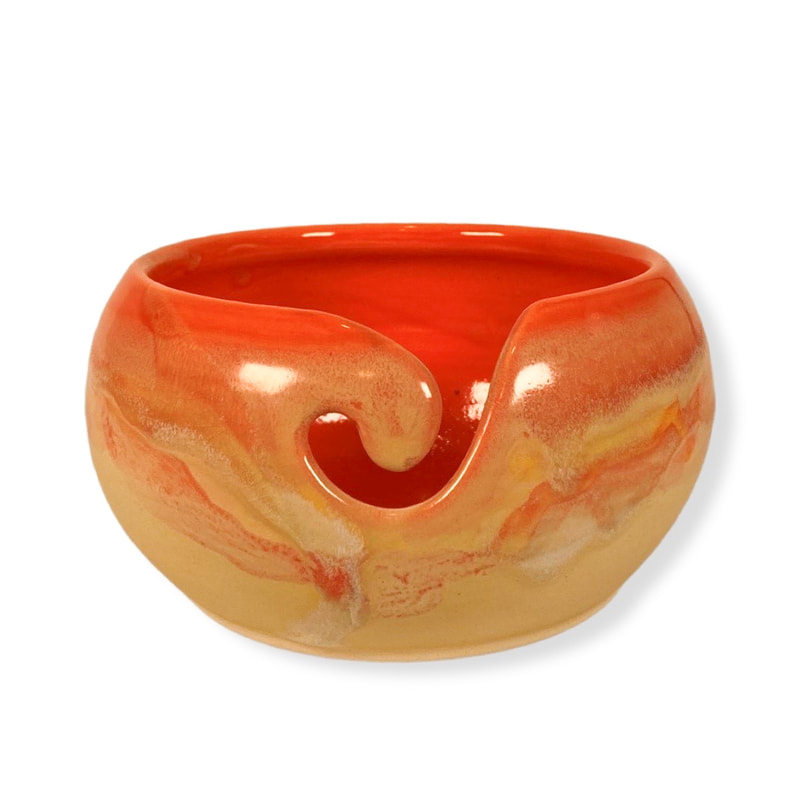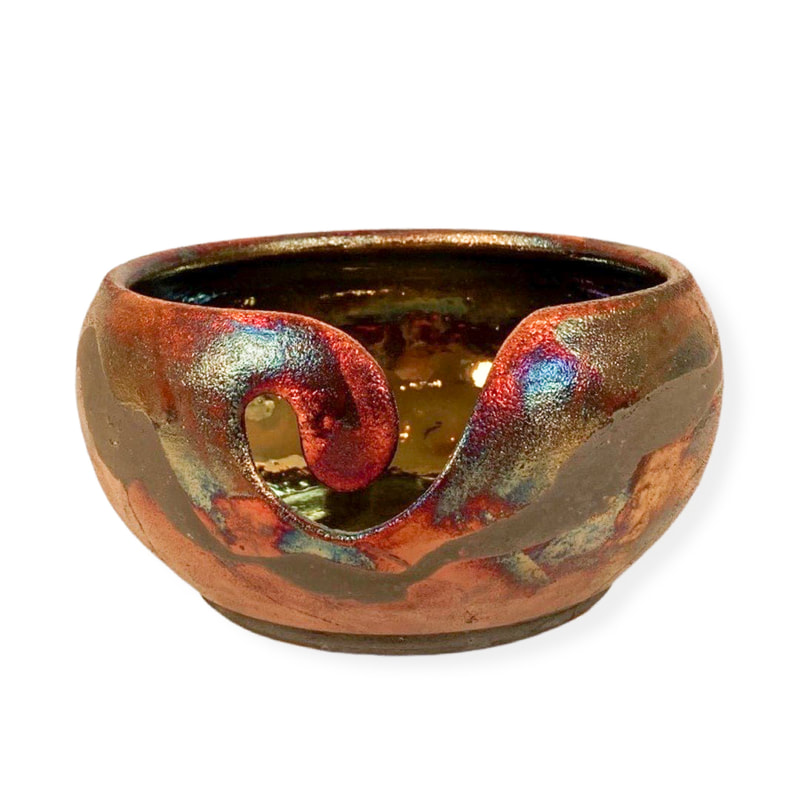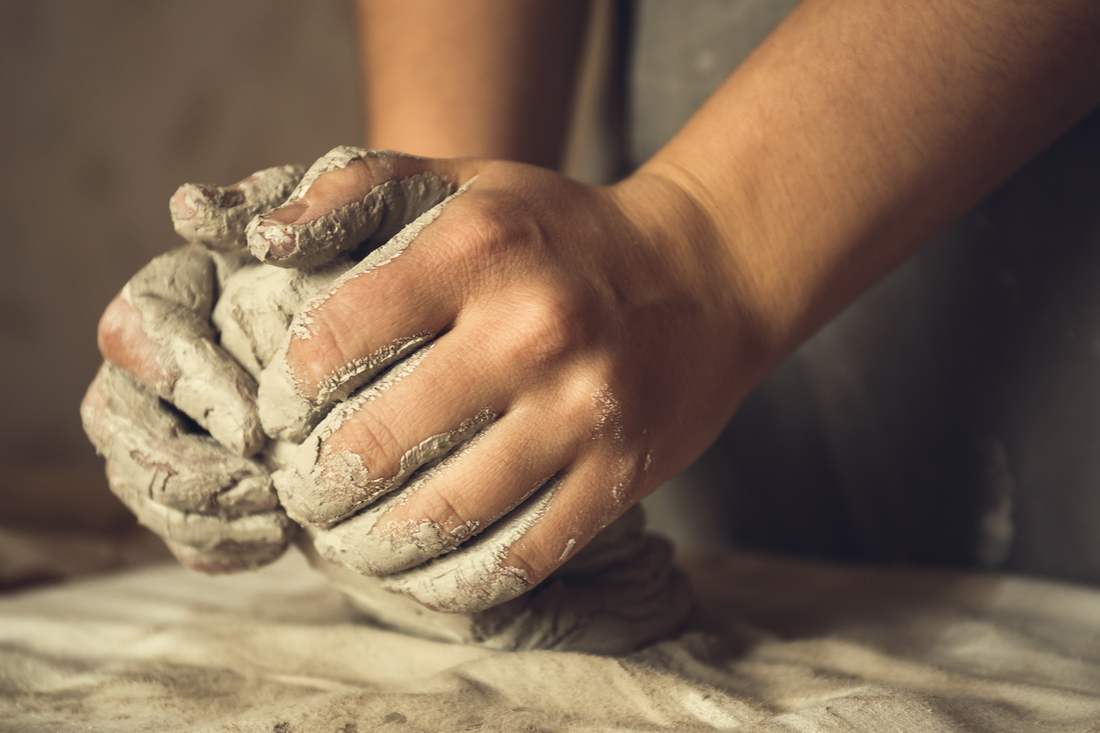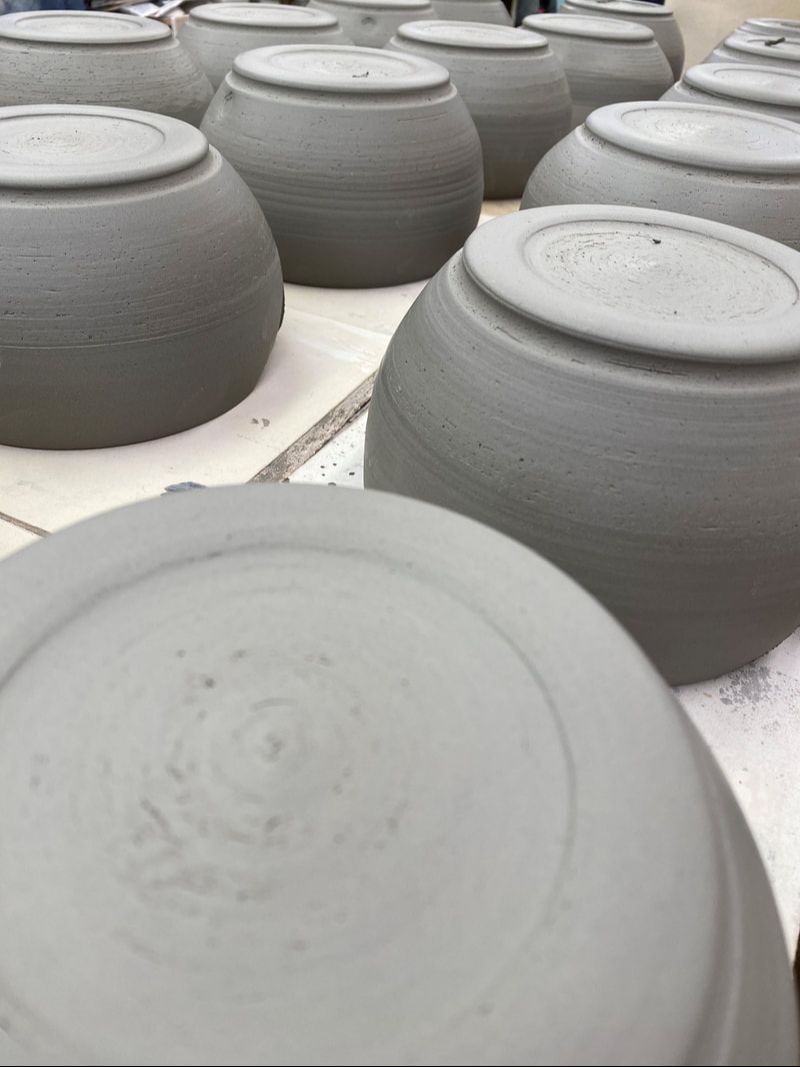0 Comments
To make raku pottery, the kiln is heated much faster than other kiln firings. It is not unusual for a raku kiln load to be fired in under an hour, as opposed to a more common firing of stone ware that will take a number of hours to heat up and then a day or more to cool. The piece is removed from the kiln with an orange glow at about 1890 degrees Fahrenheit) and is put directly into a container of combustible materials, such as newspaper, sawdust or pine needles. This results in unique textures and colors on the surface of the piece as the oxides (primarily copper) is deprived of oxygen used by the combustibles, thus turning the copper carbonate to a form of copper oxide..
The Japanese are credited with developing Raku pottery in the 16th century. There was just one purpose of the Raku method – to create and promote "natural" beauty in the are used in the traditional tea ceremony. Most Raku pottery pieces were traditionally shaped by hand rather than using a wheel. This creates pieces that are unique. The traditional method of creating Japanese Raku isn’t the same as what’s done in Western countries. With Japanese Raku, most of the pieces are made using neutral colors such as brown and black and the pieces are plunged into water without using the combustible material to reduce the piece. With Western raku, because the combustibles are used, the unglazed portions o the pot are usually carbonized black.. What Does the Term “Raku” Mean?The rough translation of Raku is “Happiness in the accident.” Some people believe this name was developed by potters who loved the process of making Raku pieces. Raku pottery is unique and interesting. There are no two pieces that will be exactly the same, thanks to the techniques used to glaze the piece. If you are looking for a great gift or just something interesting to display in your home, raku pottery should be considered. While many refer to horse hair pottery and the use of feathers, or obvara as raku, it is not. While in all these technique, a pot is taken from the kiln and manipulated by still extremely hot, raku is all about depriving oxygen from the metal oxides to created the color for which raku is known. During the pandemic, many people were looking for ways to keep their minds occupied and their hands busy. Knitting became one of the most popular activities during this crazy time in world history. The average knitting enthusiast enjoys this activity because it allows them to shift their focus from the stresses of daily life to creating various crafts with yarn.
The main thing you need to bring your yarn creations to life is the right knitting supplies. While most people are familiar with the benefits of quality knitting needles, many are unfamiliar with yarn bowls. Below is more information about yarn bowls and why investing in one is a good idea. What is a Yarn Bowl?If you are new to the world of knitting or crocheting, you might be unfamiliar with the various tools you can use to bring your yarn creations to life. A yarn bowl is an oval or round-shaped vessel designed to hold your yarn in place. Most knitting enthusiasts are familiar with the frustration that can arise when yarn rolls out of reach either under the couch or on a floor. With the help of a yarn bowl, you can keep this material in place while knitting. A yarn bowl can also help you protect yarn from tangles and hair. How To Use a Yarn BowlNow that you’re familiar with what a yarn bowl is, it is time to discuss how to use one. The first step involved in using a yarn bowl is putting your yarn cake into the vessel. Once the yarn is in the bowl, you need to find the working end of the yard. Avoid getting confused and pulling the center of the yarn out. As you start to knit and crochet, the yarn will stay snug in the bowl. Using a yarn bowl can provide a knitting enthusiast with advantages like:
While there is a bit of a learning curve when it comes to using yarn bowls, it is worth the work you invest. Once you get the hang of using a yarn bowl, you will wonder how you ever knitted without them in the past. Tips For Choosing the Right Yarn BowlYou might be surprised to learn just how many yarn bowl options are currently being sold around the world. Instead of getting overwhelmed and making a rash decision, take time to weigh all of your options before making a yarn bowl purchase. If you want to find the right yarn bowl, you need to consider factors such as:
If you are looking for a yarn bowl that is both appealing and durable, then check out the selection of products offered by Lickinflames. This carbon painted feather yarn bowl has a unique look and is handmade out of clay. We have a different philosophy of art and artisan production than you would find in a lot of other e-commerce shops.
That's evident when you get on our website – you see the breadth of design and some of the unique bits and pieces you won't find at just any old craft show or festival. Let's talk a little bit more about this and how it informs our catalog of work, both the stoneware work and our unique post-fired manipulated pieces. When you read the blog and other parts of the site, you'll see quite a lot about our processes. For example, using horsehair from old violin bows is a unique way to construct pottery that speaks to musicians and others with a penchant for traditional tunes. That’s just one example of the process that we hope transmits a story through our work. Different potters, simply speaking, have different methods. Some potters start a new design template each time they sit down. Others will create the more consistent sets of pottery, production if you will. Jim is sort of in-between the two extremes. While he does sit down and throws multiple pieces that look similar, he is crafting each one with the surface decoration in mind, that will be applied later. We continue to work on being approachable. We believe in bringing the human side back to e-commerce, and it's easy to see when you're engaged with our online store. Become one of our treasured regulars and get pottery that speaks to you! Remember, if you need something and can't put your finger on it, don't see it on the website or are trying to match a garment...email us. We are great at "concierge" shopping. Brenda and I will walk you through pieces either via email, text or zoom. Virtual shopping, what a concept. Feldspar is commonly used to make dinnerware and tiles, but crafters also use Feldspar as a flux for glass production and ceramics. Feldspar works well as a flux material to lower the melting temperature of another material. In 2022, the Feldspar mining market is expected to each up to two billion dollars due to the growing demand for mining, improving technologies, and emerging markets. However, the production of Feldspar does face obstacles such as worker safety and industry regulations.
What Is Feldspar? Feldspar is actually a group of minerals containing alumina and silica, including aluminum silicates of lime, soda, or potassium. Feldspar is the single most abundant mineral group on Earth, accounting for approximately 60% of soils, clays, and exposed rocks, and makes up principal components in rock classification schemes. History Of Feldspar Mining Mining history for Feldspar dates back to 1874, when General George Armstrong Custer led an expedition into the Dakota Territory. In the Black Hills, General Custer and the 7th Calvary discovered gold as they were camping next to a small stream. Here the mining town of Custer, South Dakota, began, and in 1928 the first Feldspar milling operation opened for business. Now, high-quality Feldspar is still being produced from the rich ore deposits and pegmatite of the Black Hills mines and many states across the country. How Feldspar Is Mined Feldspar is mined from massive bodies of granite, sands, and pegmatites. Pegmatites are formed during the final fluid stages of crystallizing granite. The granite becomes concentrated in small vapor-rich pockets and liquid that promote the growth of very large crystals. Because Feldspar is a significant component of the Earth's crust, its supply is more than adequate to meet demand. Hard-rock mining of Feldspars is primarily done by open-pit methods by contractors and mine owners. Once the Feldspar ore is drilled and blasted, it undergoes a secondary breakage with a conventional drop ball. The ore is then loaded onto trucks using hydraulic shovels and hauled to a crushing plant that is usually located next to the flotation plant. Substitutes For Feldspar Even though Feldspar is a primary material used in high-end glass making and ceramics, it can be substituted with alternative sources. Minerals that can be replaced for Feldspar include clays, pyrophyllite, talc, and quartz mixtures. However, the abundance of Feldspar makes substitutions unnecessary for crafters for the foreseeable future. When working with pottery and glass, Feldspar is still one of the best choices of materials. Finding unique items to collect and put into your home should be one of your top priorities. If you want one-of-a-kind decorative items for your residence, then you need to think about investing in custom-made pottery and coasters. The same process used to make these items is also used to make decorative shawl buttons and pins.
Every year, consumers in the United States spend billions of dollars on ceramic products. As a pottery enthusiast, finding out more about the processes used to create these items is a good idea. Raku pottery is extremely popular around the world. Read below to find out more about this process and how it is used to create breathtakingly beautiful bowls, pins and buttons. What is Raku Pottery? Roku pottery is a process that requires a kiln to be heated up much faster than traditional Kiln firings. Once the material reaches these higher temperatures, the potter will remove the piece while it still has its molten orange hue. After the piece is removed from the kiln, it is put into a container with combustible substances like sawdust. By placing the hot pottery piece in these conditions, the potter is able to create unique textures and colors on the surface. Where Did Raku Pottery Originate? In the 16th century, the Japanese invented the process of making Raku pottery. The main purpose of the development of this process was to promote the beauty of the pieces being created. Traditionally, potters that used the Raku method would shape them by hand rather than using a wheel. This handcrafted approach gave these pieces more beauty and individuality. The Raku wares constructed in Japan are still some of the most highly-valued and sought-after items in the ceramics world. Over the years, Raku potter has been considered the embodiment of Zen, which is why it is so desirable to collectors. What Does Raku Mean? The rough translation of the Japanese word Raku means “happiness in the accident”. Many Japanese elders believed that Raku was a process of achieving enlightenment. They believed that the tea bowl used during this process represented the Earth. These same elders believed that the heating process used to make Raku pottery was representative of enlightenment. The Clays Used For Raku Firing As any pottery enthusiast knows, the quality of clay used during the crafting of a piece is extremely important. In reality, any type of clay can be used during the Raku firing process. However, there are specially designed clays designed specifically for Raku. Typically, Raku clay has much better thermal shock resistance and a lower shrinkage rate. Using the right glazes is also crucial when trying to create Raku pottery pieces. Usually, low-fire glazes are used during this process. If you are buying Raku pieces from a reputable potter, they will use the materials mentioned here to craft their works of art. Now that you know more about Raku pottery, it is time to check out the pieces offered by LickinFlames. Many people may not realize that pottery can be made from different types of clay, each having unique properties that produce an intended result when used. Each type of clay consists of different colors, flexibilities, and textures that determine uses, color, firing temperature, and yielded results. With the various types of clay available on the market, knowing what you are buying will help ensure your next project is successful. Let's take a closer look at thefour types of clay used in pottery and the intended use of each.
Earthenware Clay The oldest and most commonly used clay is Earthenware clay. Earthenware clay is very beginner-friendly as it is high in plasticity. This type of clay is primarily found in warm colors such as red, brown, grey, and orange, which show well after being fired. Artists like to work with Earthenware clay as it is easily decorated withpaints and glazes. Sculptors find Earthenware clay precious and versatile, unable to be had sculpted or wheel-thrown. However, if the finished product freezes, it can crack. Ball Clay Ball clays are highly plastic and contain minimal impurities and a high percentage of quartz. Because ball clays occur naturally as sediments and have very fine minerals, they tend to lose color on firing. At the greenware stage, ball clays may be grey then obtain a light buff color after firing. When appropriately fired, some may produce a white hue, which makes it a famous clay among potters. Ball clays are also used in floor tiles, vases, and tableware. Stoneware Clay Stoneware clays have stone-like qualities and are rigid, nonporous, and moderately plastic. These clays vary in grey, white, and brown colors when wet. Firing temperature affects the final color of the product. Containing small amounts of mica and quartz, stoneware clays are easily worked and painted with underglazes, glazes, overglazes, and enamels. Stoneware clays are a popular material for tableware and are suited for both hand-building and wheel throwing. Porcelain Clay Porcelain, or China, clays are popular in dinnerware. These clays are the least plastic of the four types of clay; hence they are pretty challenging to work with. Porcelain clays are created with a large amount of mineral kaolin, giving them a very light greyish tone at the greenware stage. After firing, porcelain clays are white to off-white and can be glazed with enamels. Also known as kaolin clays, porcelain clays fire at high temperatures and produce hard water-resistant products. When choosing the suitable clay for your next project, consider the character of each of these four clays to ensure you select the right materials for your needs.
|
AuthorJim writes most of the dribble for our Banter. Sometimes it's serious, but often not...then, neither is Jim Categories |
















 RSS Feed
RSS Feed